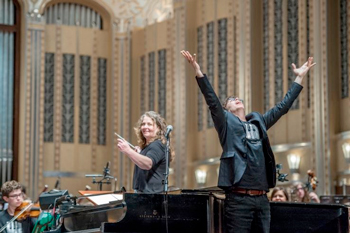by Daniel Hautzinger

The orchestra, especially the brass and percussion, were uninhibited in dynamic arrangements of Folds’s songs by Iain Grandage, Michael Pigneguy, Paul Buckmaster, Graeme Lyall, Jim Gray, and James Ledger. That freedom from restraint is often absent when young musicians perform canonical music, so hearing CYO unabashedly enjoy their parts was a joy.
Folds’s songs are uniquely fit for orchestral backing: they have an accessible clarity that lends itself to re-interpretation (he has produced an enjoyable album of college a cappella groups performing his songs), propulsive syncopations, attractive harmonies, and an endearing catchiness. These qualities especially shone in driving rockers like Steven’s Last Night, One Angry Dwarf and 200 Solemn Faces, and the encore, Army, arranged by Mau Quiros. The brass enthusiastically ripped out marching band licks over rollicking drum parts bursting with their players’ lively energy. The closer, Narcolepsy, fully engaged the whole orchestra with up-surging, climactic parts in perhaps the best arrangement of the night.
Ballads were equally effective, the violin-less Fred Jones Part 2 a particular highlight with its sensitive cello lines. Other songs benefitted from positive showmanship. Folds played standing up in a wide-legged power stance in Zak and Sara, CYO musicians Eric Poe, Ben Poe and Andrew Horvath contributed a barbershop introduction to Effington, and Folds directed the audience in harmonized singing during Not the Same. Folds even cobbled together a song on the spot with the orchestra, assigning riffs to different instruments and ad-libbing lyrics.
Such in-the-moment composition contrasted with Folds’s, extensive Concerto for Piano and Orchestra, in its Ohio premiere (and its seventh or eighth public performance, by Folds’s count). Attempts at large-scale orchestral works by popular musicians are admirable but often episodic and forgettable. Folds, however, managed to both sustain an extended structure in three movements and incorporate characteristic themes within his signature pianistic style of hand-alternating syncopations and rapidly oscillating chords. He had clearly listened to exceptional models, Gershwin and Prokofiev especially. With Joachim Horsley’s aid in orchestrating, Folds also included some interesting effects, like a gossamer transition on marimba and subdued strings, a section accompanied by beeping cell phones, and piano lines muted by reaching into the instrument’s belly.
In a brief speech near the end of the concert, Folds argued that orchestras are an important societal symbol, a model of cooperation and a vehicle for artistic happiness. He especially emphasized their significance for young people, and lauded CYO for their abilities. Hopefully the students of CYO took his words to heart; by the evidence of their glowing expressions and enthusiastic high-fives with Folds, they took away both wisdom and a memorable experience from performing with him.
Photo by Rob Muller.
Published on ClevelandClassical.com June 3, 2014.
Click here for a printable copy of this article.



